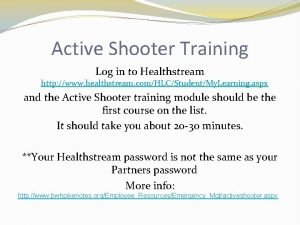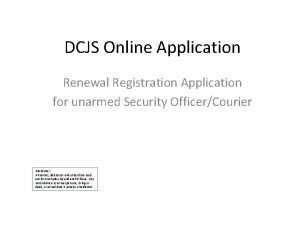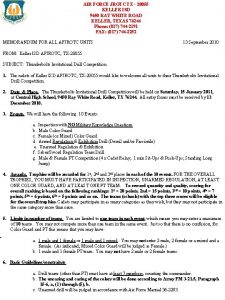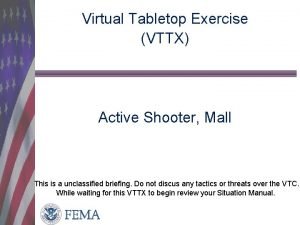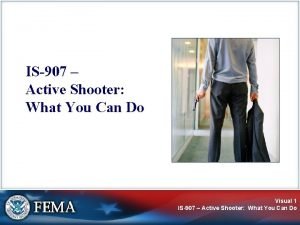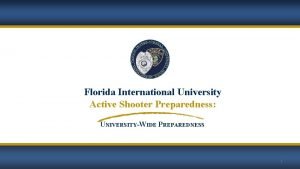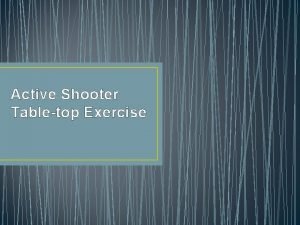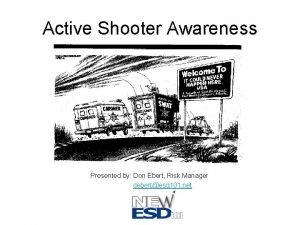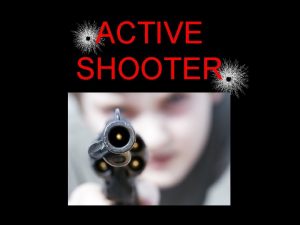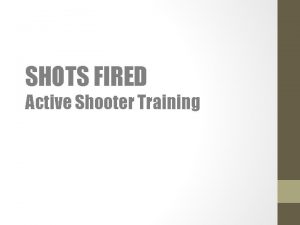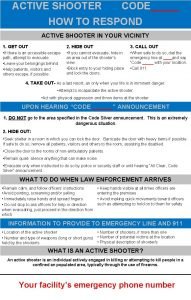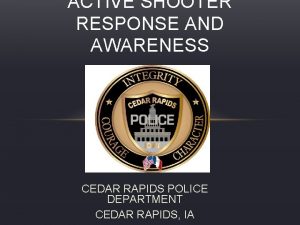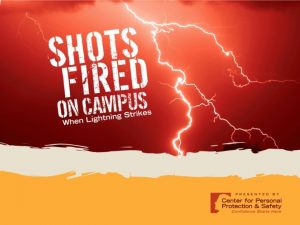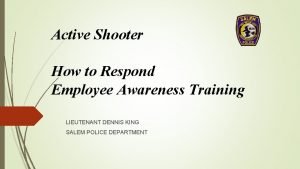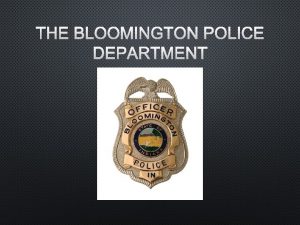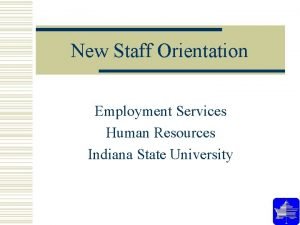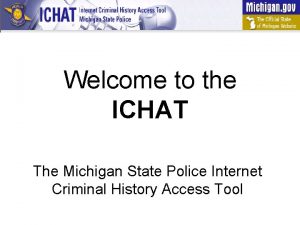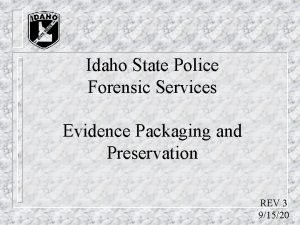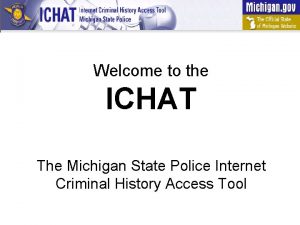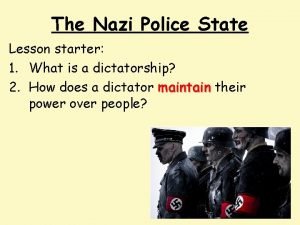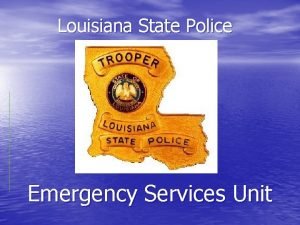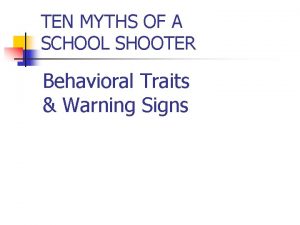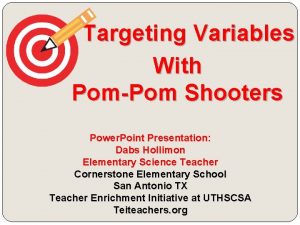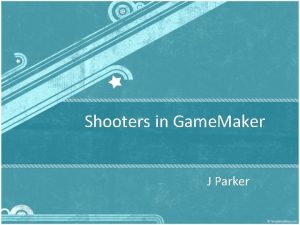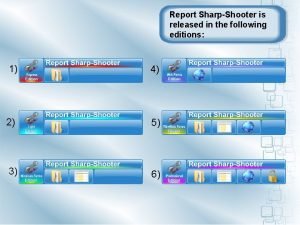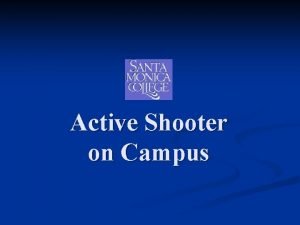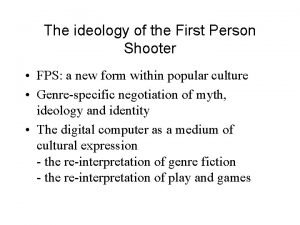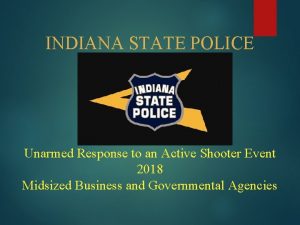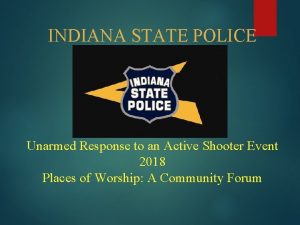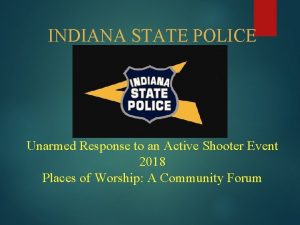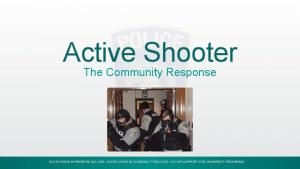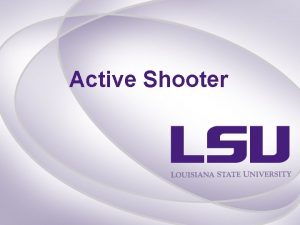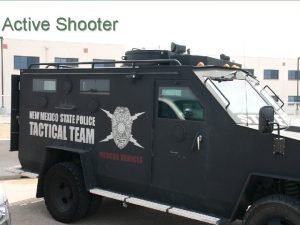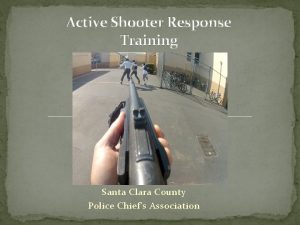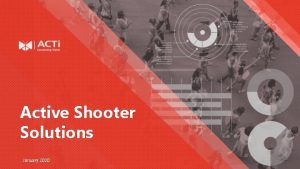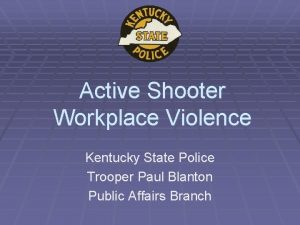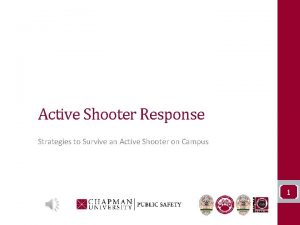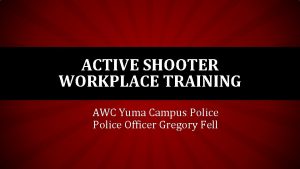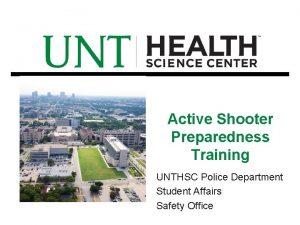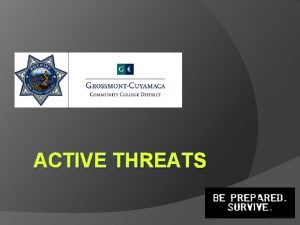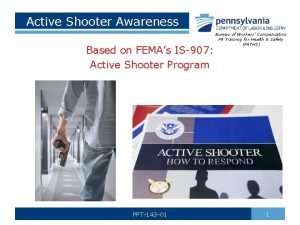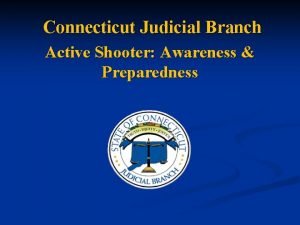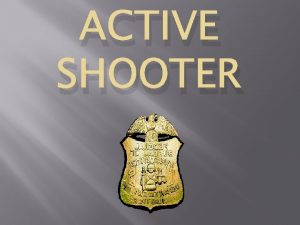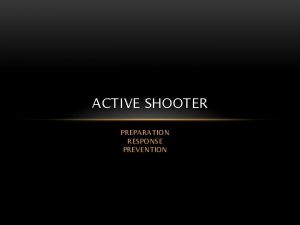INDIANA STATE POLICE UNARMED RESPONSE TO ACTIVE SHOOTER

















































- Slides: 49

INDIANA STATE POLICE UNARMED RESPONSE TO ACTIVE SHOOTER EVENTS

Disclaimer This slide presentation is offered as a free guide to school corporations in evaluating current active shooter prevention and response programs, and in developing the same. This information is not intended to comprise a complete program for preventing and responding to an active shooter event, nor is it meant to serve as a substitute for expert advice provided by local law enforcement, as well as medical, psychiatric and legal personnel. While the Indiana State Police and Dr. Richard Hogue of Hogue & Associates, Inc. have made every effort to ensure the accuracy of this information, no guarantee of accuracy or completeness is offered or implied. The Indiana State Police and Dr. Richard Hogue of Hogue & Associates, Inc. do hereby specifically disclaim any liability to any person or entity for alleged harm or damages resulting from the use or misuse of the information contained herein.

Program Objectives • Define the Active Shooter • Change the Paradigm: Prevent and Respond • Examine Current Trends and Data • Recognizing the Phases of the Active Shooter • Provide a Brief Historical Review • Discuss Early Warning Behaviors • Discuss Prevention and Response Options • Strengthening Your Program

The Active Shooter Indiana State Police Definition • One or more subjects who participates in a random or systematic shooting spree demonstrating their intent to continuously inflict death or serious bodily injury on another person or persons. For the purpose of this policy, the term “active shooter” may include the use of a variety of weapons including but not limited to firearms, knives, clubs, explosives, etc.

Change the Paradigm Prevent & Respond • The Unarmed Response to an Active Shooter program is a change in the traditional paradigm for responding to an active shooter event. This program’s focus is to provide prevention strategies and response options, so that students, teachers and staff have an increased chance of survival if faced with an active shooter event. Exercising these options may increase the security of students and staff while awaiting law enforcement arrival.

The Terrible Price

Image Source: http: //www. weremember. vt. edu/index. html

History and Data

Incident Frequency 2000 -2013 Source: Federal Bureau of Investigation, 2014 in cooperation with ALERRT

Location Categories 2000 -2013 Source: Federal Bureau of Investigation, 2014 in cooperation with ALERRT

Data Review • The active shooter may or may not have an initial target, but as the event progresses victims are often selected in a random fashion. • Typically, the event rapidly transitions to a random attack in which the victims are taken as they are encountered by the shooter. • The shooter is an opportunistic killer that often seeks out the easiest target.

Data Review • Once the carnage starts, Active Shooter Events are brief in duration. DHS reports the average to be approximately 12. 5 minutes in duration. Our review indicates that many last just 5 -7 minutes. • By an overwhelming margin, active shooter events are committed by a single offender, with over 96% of offenders being male. (Looking specifically at recent events the percentage is even higher. )* • Most school related active shooter events end with the suicide of the attacker prior to or as law enforcement arrives. Looking at recent events, (VT, Sandy Hook and Marysville), all ended in the suicide of the shooter. *FBI: A Study of Active Shooters in the United States Between 2000 & 2013

Data Review • Statistics will vary but most sources will suggest that at least 93% of active shooter events are planned. * • In the planning process, charts and maps are often constructed along with the stockpiling of an arsenal of guns, homemade bombs and assorted weapons. • Often the shooters study and research school shooting events and demonstrate a fascination for carnage on a large scale. • These events are often planned in plain sight! *FBI/NCAVC/Secret Service, “The Active Shooter: A Quick Reference Guide”

Data Review • Eighty percent or more of the time, shooters will share their intentions with others. * • While there is no ironclad profile of an active shooter, 93% of perpetrators engaged in behavior that caused others to be concerned. * • Even more concerning, in nearly 2/3 of active shooter events, more than one person had information about the attack before it occurred! * *FBI/NCAVC/Secret Service, “The Active Shooter: A Quick Reference Guide”

Five Stages Of the Active Shooter • • • Fantasy Planning Preparation Approach Implementation "Five Stages of the Active Shooter, ” Developed by Lt. Dan Marcou, La Crosse, WI Police Department (retired)

Historical Overview Year Location Casualties 1974 Brownstown, IN AD & AP killed 1997 Pearl, MS 3 killed, 7 injured 1997 Paducah, KY 3 killed, 5 injured 1998 Jonesboro, AR 5 killed, 10 injured 1998 Springfield, OR 2 killed, 23 injured 1999 Littleton, CO 13 killed, 24 injured

Historical Overview Year Location Casualties 2002 Red Lake, MN 10 killed, 7 injured 2007 Blacksburg, VA 32 killed, 17 injured 2008 De. Kalb, IL 5 killed, 21 injured 2011 Martinsville, IN 2012 Newton, CT 2014 Marysville, WA (Virginia Tech University) (Sandy Hook Elementary) 1 injured 26 killed, 2 injured 5 killed, 3 injured

The Scope of the Active Shooter Events (News Clips) VIDEO: School Shooting News Clips

Consistent Early Warning Indicators • Depression • Manifestation of emotional/mental health issues • Feelings of being rejected or bullied/bullying & desire for revenge • Experience of significant loss • Indications of planning • Fascination with past AS events & the desire for fame • Accumulation of weapons • Communication of intent to peers

Types of Preparedness • Two Types of Preparedness • Organizational Preparedness: • Can be defined as what your school can do to assist you in being prepared. • Individual Preparedness • Can be viewed as your ability to recognize, analyze, internalize and respond to threats.

Organizational Preparedness: (Responsibility of the Administration) • Establish District & Campus Safety Teams • Develop an inventory or tool (“Threat Assessment Survey/Inventory”) to identify threats existing in your school community • Use the “survey/inventory” to conduct a “Threat Assessment Survey/Inventory” of your “School Community and Campuses” • Develop safety plans that address the identified threats in school community and on your campuses • Practice, test and revise your plan based on debriefing reports from drills and input from school community members

Organizational Preparedness (Responsibilities of the Administration: Programs and Staff Development) • Educate all members of the school community on the Early Warning Indicators/Behaviors • Develop programs that promote a climate of communication between students and adults • Conduct drills and tabletop exercises designed and conducted by staff & empower staff to sound the alarm • Train staff on dealing with difficult people & their role in the school safety plan (including visitor control)

Organizational Preparedness (Responsibilities of the Administration: Maintenance of the Physical Plant) • Secure the perimeter of the facility • Control access to the facility • Provide the hardware to rapidly secure classroom doors • Provide staff with the tools necessary to sound the alarm, lockdown the facility, call 911 and take necessary action • Establish an emergency notification system that is dedicated to the school safety program

Organizational Preparedness (Responsibilities of the Administration: Create a Student Intervention Assessment Team) • Define the purpose of the Student Intervention Assessment Team: • Identification of individuals demonstrating the “Early Warning Indicators” • Develop a Threat Assessment Team on each campus for evaluating the need for intervention • Utilize a cross section of school community members to serve on the committee • Train the team on the Early Warning Indicators • Publish, train, and educate members of the school community on the Early Warning Indicators

Personal and Individual Preparedness: Determine your degree of preparedness. 1. 2. 3. 4. How well do you know your plan? How well do you know your role in the plan? Have you practiced your plan? Are you prepared to carry out your responsibilities in a crisis event? 5. How well do you know the Early Warning Indicators/Behaviors? 6. Do you know how to access the Intervention/Threat Assessment process? 7. How well do you know your students, parents and community members?

Personal and Individual Preparation Being prepared to survive an active shooter event requires both “Organizational” and “Individual/Personal” preparedness. A key to preparedness is Awareness Situational Awareness: Be aware of what is going on around you! Heightened Personal Awareness: Develop a healthy degree of mistrust/suspicion.

When you are not aware of your surroundings, bad things happen! VIDEO: Situational Awareness

Your Role in Surviving an Active Shooter Event Individual or Personal Preparedness A key to “Individual or Personal Preparedness” is your ability to live in a state of “Heightened Awareness”. This state will assist you in: Recognizing the presence of threats Analyzing & Internalizing the presence of the threat (determine a plan of action) Recognizing that you are responsible for those in your charge will greatly assist you in overcoming your reluctance to take lethal action against another human being.

“Key to Keeping Your Kids Safe is Preparing Yourself to Act!” “In any moment of decision, the best thing you can do is the right thing, the next best thing is the wrong thing, and the worst thing you can do is nothing. ” Theodore Roosevelt You must have a plan. Taking action to protect you and those in your charge is a far better choice than doing nothing.

Dynamics of an Active Shooter Event The Shooter’s Actions: The “Shooter” plans. The “Shooter” arrives and seeks victims. The “Shooter” takes victims randomly. The Mindset of the Shooter: The “Shooter” seeks to create maximum carnage. The “Shooter” views victims as just targets. Your options: You should seek to prevent contact with the “Shooter” by “Escaping”, “Locking Down”, or as a last result “Fighting” (utilizing the principles we will discuss).

Active Shooter Event Options Escape or Run Escape is an option in the event you have a secured path to a predetermined or confirmed secured area. Lockdown or Hide If a secure path or an exit site is not a certainty, “Lockdown” may be the very best option. Fight When faced with imminent danger, take lethal action.

Option to Escape/Run 1. Have a safe path and destination (with alternate) in mind. HAVE A PLAN 2. Escaping is one of your best options IF you have a safe path to a secure site! 3. Do not attempt to evacuate if you do not know where threat is located. 4. Leaving a secure place for an unknown option may take you directly into the threat! 5. Leave your possessions (warn others) but do not slow your escape.

Option to Escape/Run 6. As you evacuate, understand the concepts of concealment and cover. 7. Concealment should hide you while sufficient cover may stop a bullet. 8. Quickly check corners, intersections and rooms before you move into or through them. 9. PRACTICE your Option to Escape.

Lockdown/Hide: Remember you have been empowered to sound the alarm! 1. Quickly lock and secure the door. 2. Put as much furniture as possible in doorway to create a secure barricade. 3. Put as much ‘cover’ between you and the threat as possible. 4. Stay out of the line of sight/fire. 5. Do not make yourself an easy target. (Stay on your feet ready to move. )

Option to Lockdown/Hide 6. Silence your cell phone and/or pager. 7. If you can silence your cell phone and leave an open line to 911. 8. Turn off any source of noise and remain quiet, i. e. , radios or televisions. 9. Remember that ‘cover’ is your goal. Hiding behind large items (cabinets, desks or solid walls) is best. 10. PRACTICE your Option to Lockdown

If the classroom is being breached: Option to Fight 1. Obtain improvised weapons. 2. Teachers, aides, and (depending on school policy) age appropriate students should be positioned out of the line of sight/fire with as much cover as possible. 3. Your goal is to obtain cover while bringing the attacker into your “circle of violence. ” 4. You must be ready to take lethal action. You are capable of doing more if you are prepared to do so. 5. PRACTICE your Option to Fight

Active Shooter Video VIDEO: Unarmed Response to an Active Shooter Event in a School

School Bus Safety A different set of challenges!

Escape, Lockdown, Fight applied to a school bus. ESCAPE or RUN Leave before threat enters the bus Evacuate students If you do run without students to save yourself can you live with the possible outcome. LOCKDOWN or HIDE Secure the bus – Don’t allow threat on bus! Limited options – Concealment – NO COVER Behind Seats Under Seats FIGHT Possibly only option that COULD allow SOME passengers to escape. Loud Verbal Commands – “GET OFF THE BUS”

Know and understand your options on a school bus What kind of weapon is being used? If stationary can passengers be evacuated? If in motion Throw shooter off balance; gain the advantage Abruptly set parking brake Swerve left and right Activate lights to gain attention Can you radio in a predetermined code?

Know and understand your options on a school bus What can be used as a last resort weapon? Tire iron Fire Extinguisher Purse/Bag/Backpack Seat belt cutter Whatever you decide DON’T HESITATE! If contact is made with attacker order all passengers to evacuate!

School Bus Drivers Unarmed Response Training Video 1 VIDEO: Unarmed Response to an Active Shooter Event on a School Bus – Scenarios 1 & 2

School Bus Drivers Unarmed Response Training Video 2 VIDEO: Unarmed Response to an Active Shooter Event on a School Bus – Scenarios 3, 4, & 5

Reunification Considerations Suggestions to strengthen your program! Locate secure backup sites off campus away from the danger. Keep evacuation supplies at the back up site! Develop MOU (Memorandum of Understanding) with the sites current owner. Develop ‘Evacuation Kits’ that are available to all teachers, administrators, transportation staff, healthcare professionals and food services staff (segregated by responsibility). Develop ‘Evacuation Kits’ with the assistance of EMTs, nursing staff, teachers, administration and the special needs staff. Many classrooms have students with unique and special needs students. Remember to accommodate them.

Law Enforcement Arrival Law enforcement: Remember Law Enforcement may arrive in or out of uniform! Full dress uniform Plain clothes Full tactical gear They will bypass the wounded! They will be forceful! You should expect law enforcement to make their identity known!

Law Enforcement Arrival Do not attempt to reach out for arriving law enforcement. You will put both of you at risk if you do so. Keep hands empty and clearly visible. If you are able, supply arriving law enforcement with information on the shooter’s direction, location, (sex, race, hair color), type of weapon, etc. Call 911 if you are in a secure and safe place. Make sure that by calling you do not call attention to your location. “ 911 Emergency Information Quick Reference Guide” will be posted on the ISP Website to assist you in anticipating the dispatcher’s requested information.

Suggestions for Consideration Increase “Law Enforcement Visibility” on your campuses! Partner and develop relationships with local, county & state law enforcement to bring officers onto your campuses. Utilize local LE, SRO and Safety Specialists to develop an “All Hazards” Safety Plan” Utilize them to develop drills to test your plan. Invite law enforcement to your campus for career days, as a guest speaker, for staff development programs, for extracurricular programs, for breakfast and or lunch with staff and students, etc. Create a satellite police station and work place for local, county and state law enforcement.

Suggestions for Consideration Empower your staff to participate and take an active role in the campus and district safety plan. Include staff on Threat Assessment Teams (Both the corporation Threat Assessment Team that identifies threats present in the school community and the Threat Assessment Intervention Team that identifies students that exhibit the Early Warning Behaviors!) Empower all members of the faculty and staff to sound the alarm and call 911! Make your expectations clear that faculty and staff are responsible implementing the school safety plan (maintaining perimeter security, monitoring visitor traffic, being vigilant, conducting and planning drills, revising the safety plan etc. ) Hold them accountable!

Suggestions for Consideration Conduct a Comprehensive Threat Assessment ISP will provide Threat Assessment Training to groups of “County Commissions”. They will train you to do your own Threat Assessment. You know your school community better than anyone. Understand that, like law enforcement, educators are most often willing to die for those in their charge. In the application of this plan, we are asking them to live for those in their charge by implementing the strategies we have outlined.
 Active shooter healthstream
Active shooter healthstream Indiana state police lab request form
Indiana state police lab request form Dcjs unarmed security renewal online
Dcjs unarmed security renewal online Unarmed regulation drill sequence
Unarmed regulation drill sequence Active shooter tabletop exercise
Active shooter tabletop exercise Is 907 active shooter
Is 907 active shooter Fiu active shooter
Fiu active shooter Run hide fight
Run hide fight Active shooter tabletop exercise
Active shooter tabletop exercise Bath assessment active shooter
Bath assessment active shooter Peter odighizuwa
Peter odighizuwa Extreme danger gap
Extreme danger gap Active shooter code
Active shooter code Active shooter tabletop exercise
Active shooter tabletop exercise Active shooter cedar rapids
Active shooter cedar rapids Survival mindset active shooter
Survival mindset active shooter Active shooter healthstream
Active shooter healthstream Bloomington indiana police department
Bloomington indiana police department Jennifer peshke
Jennifer peshke Indiana 3rd grade math standards
Indiana 3rd grade math standards Termidoe
Termidoe Indiana state orientation
Indiana state orientation Indiana state contracts
Indiana state contracts What is indiana's state motto
What is indiana's state motto Indiana state board of animal health
Indiana state board of animal health Ichat michigan
Ichat michigan Michigan state police teenage defensive driving
Michigan state police teenage defensive driving Latvian state police
Latvian state police Ipes certified carriers
Ipes certified carriers Ispfs
Ispfs Virginia form sp-65
Virginia form sp-65 Ichat michigan
Ichat michigan Delaware information and analysis center
Delaware information and analysis center Nazi police state lesson
Nazi police state lesson Nazi
Nazi Louisiana tier ii reporting
Louisiana tier ii reporting Natural and forced response
Natural and forced response First order system transfer function
First order system transfer function Primary immune response and secondary immune response
Primary immune response and secondary immune response School shooter traits
School shooter traits Pom pom shooter
Pom pom shooter Shooter game maker
Shooter game maker Report sharp shooter
Report sharp shooter Unity top down shooter tutorial
Unity top down shooter tutorial Nnn shooter
Nnn shooter Nt myers briggs
Nt myers briggs Fort hood major hasan
Fort hood major hasan First person shooter ideology
First person shooter ideology Active high and active low
Active high and active low Primary active transport and secondary active transport
Primary active transport and secondary active transport
